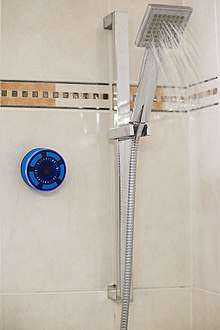Wireless speaker
Wireless speakers are loudspeakers which receive audio signals using radio frequency (RF) waves rather than over audio cables. The two most popular RF frequencies that support audio transmission to wireless loudspeakers include a variation of WiFi IEEE 802.11, while others depend on Bluetooth to transmit audio data to the receiving speaker.[1]
.jpg)
Overview
Wireless speakers are composed of two units: a main speaker unit combining the loudspeaker itself with an RF receiver, and an RF transmitter unit. The transmitter connects to the audio output of any audio devices such as hi-fi equipment, televisions, computers, mp3 players, etc. An RCA plug is normally used to achieve this. The receiver is positioned where the listener wants the sound to be, providing the freedom to move the wireless speakers around without the need of using cables. The receiver/speaker unit generally contains an amplifier to boost the audio signal to the loudspeaker; it is powered either by batteries or by an AC electric outlet.[2]
The signal frequency range used by wireless speakers is generally the same as that used by cordless telephones — 900 MHz. The RF signal can traverse walls and floors/ceilings. Most manufacturers claim the signal transmits over a range of 150 to 300 feet (50 to 100 m). Many wireless speakers feature variable transmission channels that can be set using a tuning knob to overcome potential RF interference with other nearby wireless devices, such as cordless phones or baby monitors.
Some wireless speakers use the 2.4 GHz frequency band.
Sound quality
The most basic models only offer an output power of 3W, which does not allow for an optimal sound quality. Mid-range models go up to 5W and high-end models can go up to 10W and beyond.
The number of speakers can also vary: while entry-level models are limited to a single speaker, more elaborate models can offer two, and thus have stereo sound reproduction. Some wireless speakers add a passive radiator to improve low frequency reproduction and achieve deeper sound.[3]
Bluetooth
Recent models generally use Bluetooth 4.0 or even Bluetooth 5, and wireless speakers generally have a range of 10 meters. Bluetooth devices use a radio communication frequency such that the devices do not have to be in a visual line of sight with each other.
Some speakers may benefit from the NFC system to facilitate pairing with the source device.
Battery
Wireless speakers use rechargeable batteries to power them. The operating time of the speaker before it has to be recharged is usually 6 hours. Models with more powerful batteries can last up to 10 hours or more. Almost all wireless speakers operate on rechargeable batteries that are not replaceable, so that the lifespan of these speakers is that of their batteries.
In order to be recharged, wireless speakers must be connected to an electrical source by means of a Micro Usb cable.[4] The complete charging cycle generally varies from 3 to 6 hours.
Hybrid wireless speakers
Starting 2015, some wireless speakers integrate VOIP telephony functions.[5] Other models have an integrated FM radio. The higher end models add an LCD screen to make it easier to select and store radio stations.
Most wireless speakers have a built-in microphone, which allows to receive and make calls using a mobile phone in hands-free mode. When a call comes in, the music automatically shuts off and resumes as soon as the call ends.
With the development of voice assistants, manufacturers have integrated the ability to pair them with their devices. This way, commands can be passed to the speaker via the integrated microphone, which will then be executed by the voice assistant.[6]
Shower speaker

A shower speaker is a Bluetooth speaker designed for use in humid environments such as showers or more generally in the bathroom. There are also shower speakers using Wi-Fi, although this is more rare.
The speaker must first be paired with a Bluetooth device. In general, it is a smartphone or tablet. It is this device that will serve as the source for the music that will be played through the speaker.
A shower speaker must first of all be able to withstand water splashes. This resistance is expressed by an IP (Ingress Protection) index that must be mentioned on the product. The most frequent indexes encountered are the IPX4 index, which indicates that the device is protected against splashes. Other models offer superior protection, such as IPX7. In this case, the enclosure is completely submersible in water to a depth of 1 meter for half an hour. It is then considered waterproof. Some models, rarer those, extend their protection up to index 8.
The shower speaker must be able to be installed in all environments. This is why manufacturers have planned to equip their devices with different ways of fixing them. The suction cup is the most basic system and is found on entry-level speakers. Its main disadvantage is poor adhesion to the shower wall, which can cause the unit to fall off. The mounting bracket is the safest system to fix the speaker, but requires drilling a hole in the wall. The carabiner clip allows the speaker to hang from the shower curtain bar. It is only suitable for the smallest and lightest models.
References
| Wikimedia Commons has media related to Wireless speakers. |
- "Best Wireless Speakers 2017". 30 November 2015.
- "How Wireless Speakers Work". 1 June 2012.
- "Q. What are the advantages of passive radiator design?". www.soundonsound.com. Retrieved 2019-11-07.
- "Help Guide | Charging the speaker from an AC outlet". helpguide.sony.net. Retrieved 2019-11-07.
- "10 gadgets to make your old tech smarter". 11 January 2015.
- "These Smart Speakers Do Your Bidding, And Have Killer Sound Quality". Fatherly. 2018-09-07. Retrieved 2019-11-07.